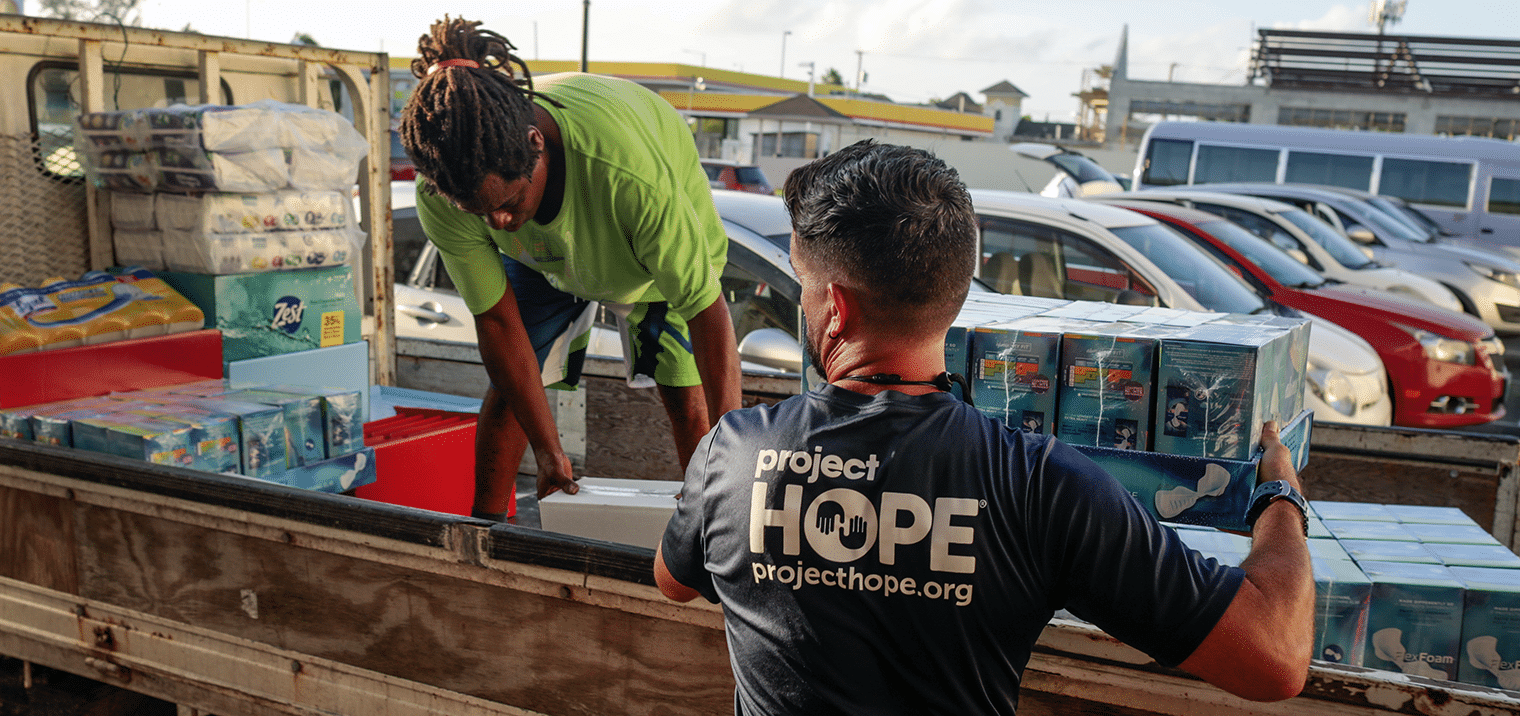
Hurricane Dorian: What You Need To Know
On September 1, Hurricane Dorian slammed into the Bahamas as a massive Category 5 storm, causing catastrophic damage on Abaco and Grand Bahama Island. Project HOPE is on the ground meeting people’s medical needs and helping the islands prepare for the long recovery ahead. Get the facts about this storm and learn more about how you can help now.
One of the strongest Atlantic hurricanes on record
Hurricane Dorian entered the Caribbean as a tropical storm and rapidly intensified into one of the strongest Atlantic hurricanes ever recorded. After passing east of Puerto Rico, Dorian moved north toward the Bahamas and slammed into the Abaco Islands and Grand Bahama Island as a devastating Category 5 hurricane. Reports show absolute destruction on Abaco and Grand Bahama Island, where Dorian’s sustained winds reached 185 miles per hour — the strongest storm to ever hit the Bahamas.1
Project HOPE is on the ground in the Bahamas supporting emergency response efforts and helping the islands prepare for the long road to recovery.

The Latest Developments
November 6, 2019: Project HOPE Launches First-Aid Trainings While Shifting Volunteer Presence to Abaco
Project HOPE’s emergency response team continues to respond to health needs of Hurricane Dorian survivors in the Bahamas. As shelter populations on New Providence Island continue to decline, the focus is shifting from immediate response and assistance to the recovery and rebuilding of Abaco. Activities to restore power, repair infrastructure and reopen health facilities are underway; however, the recovery phase is expected to be long as much of the island remains uninhabitable.
On October 28, Project HOPE began implementing first-aid training and kit distributions with evacuees and external community members on New Providence Island. Trainings are being conducted in partnership with EPECARE, a U.S.-based nonprofit, which uses Creole-speaking trainers in order to reach the island’s Haitian population. Project HOPE procured 980 first-aid kits to distribute to training participants, and a total of 180 beneficiaries were reached in the first week.
At the request of the Ministry of Health, Project HOPE is transitioning its team of medical volunteers from New Providence to Marsh Harbour Community Clinic on Abaco, were HOPE has been providing support since the storm hit in September. There is currently a shortage of physicians at Marsh Harbour, and it is difficult to recruit and place government medical staff at the clinic. Project HOPE will support the clinic with volunteer rotations of medical doctors, nurses and pharmacists until a staffing plan for the clinic is secured.
HOPE is working to expand the first-aid training program to communities in Abaco beginning the first week of December. Trainings will aim to reach Haitian communities, government workers, community-based organizations, local NGOs and community leaders.
In total, HOPE has provided direct health services to 1,310 displaced survivors and distributed more than $719,000 in medicines and supplies, including 15,610 hygiene kits. More than 25 expert volunteers have been deployed to-date, including medical doctors, nurse practitioners, registered nurses, pharmacists and a water system engineer.
October 16, 2019: Project HOPE Coordinating with the Ministry of Health to Continue Services as Shelter Populations Decline
As shelter populations decline across New Providence Island, Project HOPE remains on the ground to provide needed humanitarian assistance while coordinating with the Ministry of Health to begin focusing our response on the islands’ recovery.
Though the Ministry of Health has begun consolidating the shelters on New Providence Island, the need in the Bahamas is still great: Thousands of people remain displaced, and all health facilities on Great Abaco Island are in need of infrastructure repair and restoration. HOPE’s director of emergency response, Tom Cotter, will return to Nassau next week to assess the greatest need and begin the next phase of our response. Project HOPE is expected to provide response activities through at least the end of December.
Additionally, Project HOPE will begin implementing first-aid training in shelters and Haitian community churches in Nassau later this month, as well as kit distribution activities in partnership with EPECare. A shipment of 11,200 hygiene kits from the Church of Latter-day Saints arrived in the Bahamas on October 7 and went to the Department of Social Services for use in all shelters as needed, including those on Grand Bahama and Abaco.
Project HOPE has now provided direct care to more than 1,180 patients through its work at shelter clinics as well as through its school health screening initiative.
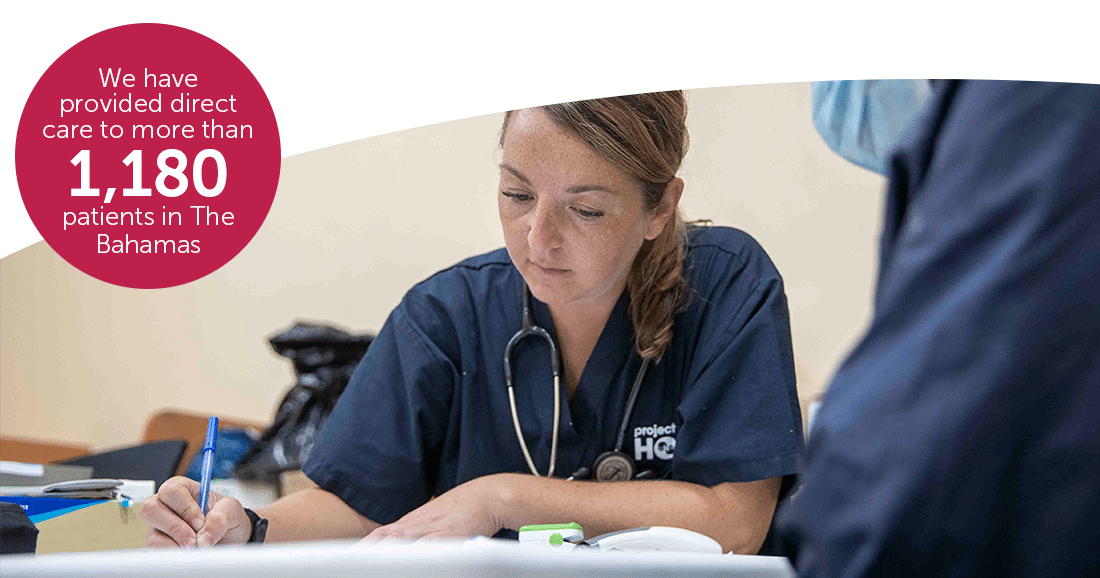
October 8, 2019: Project HOPE Preparing First-Aid Trainings As Response Continues on New Providence Island
Project HOPE continues to provide needed humanitarian assistance and health care in the Bahamas, focused primarily in Nassau. HOPE is providing health care, medicines and medical supplies in three shelters in and around Nassau daily, as well as school health screenings for hundreds of students who evacuated from Abaco or Grand Bahama Island.
Later this month, Project HOPE will begin implementing a first-aid training and kit distribution activity in all seven shelters on New Providence Island. Trainers will be Creole-speaking and will work with the heads of household for approximately 600 families across all shelters. Project HOPE has procured 985 first-aid kids, which are in the process of being shipped to Nassau and will be distributed to training participants.
Additionally, HOPE is preparing for the arrival of 11,200 hygiene kits donated by the Church of Latter-day Saints, which will be handed over to the Department of Social Services for distribution in all shelters on New Providence. Three interagency emergency health kits donated by MAP International were handed over to the Ministry of Health on September 27.
HOPE’s emergency response team has provided direct care to more than 900 patients so far in shelters and school screenings. Response activities are currently expected to go through the end of December with the possibility to extend.
September 25, 2019: Project HOPE Continues Daily Health Care in the Bahamas As Need Expected to Continue into November
Three weeks after Hurricane Dorian devastated the northern Bahamas, Project HOPE continues to provide health care, medicines and medical supplies to hurricane survivors. To date, HOPE has provided health care at five shelters housing evacuees from Hurricane Dorian and has provided direct care to more than 600 patients through shelter clinics and school health screenings.
HOPE’s emergency response team is currently serving three shelter clinics daily, where the top health concerns are acute respiratory infections, skin diseases, hypertension and minor injuries. Other health concerns have included cases of mastitis, diabetes, headaches and mental health needs.
As part of HOPE’s ongoing support for Marsh Harbour Community Clinic on Abaco, the team deployed a volunteer water engineer and pharmacist this week to assess the clinic’s water system and inventory management system. Additionally, HOPE expects to receive three interagency emergency health kits donated by MAP International as well as 11,200 hygiene kits donated by the Church of Jesus Chris Latter-Day Saints in the coming days.
The Ministry of Health has formally requested HOPE to continue its work in shelters in and around Nassau through November 20. As part of our evolving response, the team is preparing to implement first-aid training at shelters combined with the distribution of first-aid kits. HOPE is working to identify Haitian Creole-speaking trainers as there is a large population of people of Haitian descent in the shelters.
September 23, 2019: Project HOPE Scaling Up Health Care Activities as Need Continues for Survivors and Evacuees
Three weeks after Hurricane Dorian devastated the northern Bahamas, Project HOPE continues to provide health care, medicines and medical supplies to hurricane survivors, including daily health care in three shelters in and around Nassau.
The top health concerns observed by our team include wounds and injuries, diabetes, gastrointestinal illness and skin diseases. Because many people with diabetes have lost their supplies, HOPE has been distributing glucometers that enable patients to check their sugars for at least two months.
Project HOPE also continues to provide health screenings to evacuee children in need of school placement. The Ministry of Education and Department of Social Services estimates that as many as 2,500 evacuee children require screenings, and as the school year began on September 4, this is an urgent need to get children screened so they do not fall behind.
On Abaco, Project HOPE continues to support the Marsh Harbour Community Clinic and is deploying a volunteer water engineer to conduct an assessment of the clinic’s water system.
As response agencies begin to leave the Bahamas, Project HOPE is communicating with the Ministry of Health to scale up health care activities at clinics in order to cover any gaps left by departing organizations. Our emergency response team is in the process of planning first-aid training and first-aid kit distributions for hundreds of families and is planning to receive a donation of more than 11,000 hygiene kits for distribution in early October.
September 17, 2019: Project HOPE Scales Up Health Activities to Support Evacuees in Nassau
Project HOPE’s emergency response team is scaling up its work to meet the health needs of evacuees following Hurricane Dorian. In Nassau’s Fox Hill Community Center, HOPE is providing exams, wellness checks and referrals for people with medical conditions including hyperglycemia, hypertension and bronchitis. The team is also providing health screenings for evacuee children who will be attending school in Nassau.
Additionally, Project HOPE has delivered an additional 21 pallets of medicines and supplies to the Ministry of Health, including 3,150 disaster hygiene kits. The shipment includes pharmaceuticals like prednisone, amoxicillin, metformin, aspirin and azithromycin, as well as supplies like foam bandages, coveralls, safety eyewear, feminine pads, exam gloves and respirators.
Eight Project HOPE volunteers have been cleared to provide patient care in the Bahamas, including five physicians, two registered nurses and a nurse practitioner. A water engineer will also be joining the team this week to begin work on Grand Bahama Island. As HOPE continues to assess conditions inside shelters, anticipated needs will be psychosocial, hygiene, chronic and acute health needs.
September 13, 2019: Project HOPE Opens First Wellness Station to Support Displaced Survivors from Hurricane Dorian
Project HOPE’s emergency response team has opened its first wellness station in Nassau to help meet the health needs of evacuees from Hurricane Dorian. The station, located inside the Fox Hill Community Shelter, includes a triage and exam area where HOPE is assisting in the treatment of patients for medical needs such as urinary tract infection, upper respiratory infection, wound infection, chest pain, hyperglycemia, gastroesophageal reflux disease and asthma. Additional needs the team observed were primarily related to heart disease, hypertension and diabetes.
HOPE is working alongside staff from Elizabeth Estates Hospital, which operates the shelter clinic. Anticipated future needs inside the clinic include inventory supply and management, pharmaceutical needs, staffing, continued clinic setup and hygiene supplies.
HOPE will continue to establish wellness check areas in coordination with shelters as needed and has begun to identify future locations. Five medical volunteers (two medical doctors, two registered nurses and a pharmacist) will be joining the team next week to expand this effort and continue providing needed health assistance and support to hurricane survivors.
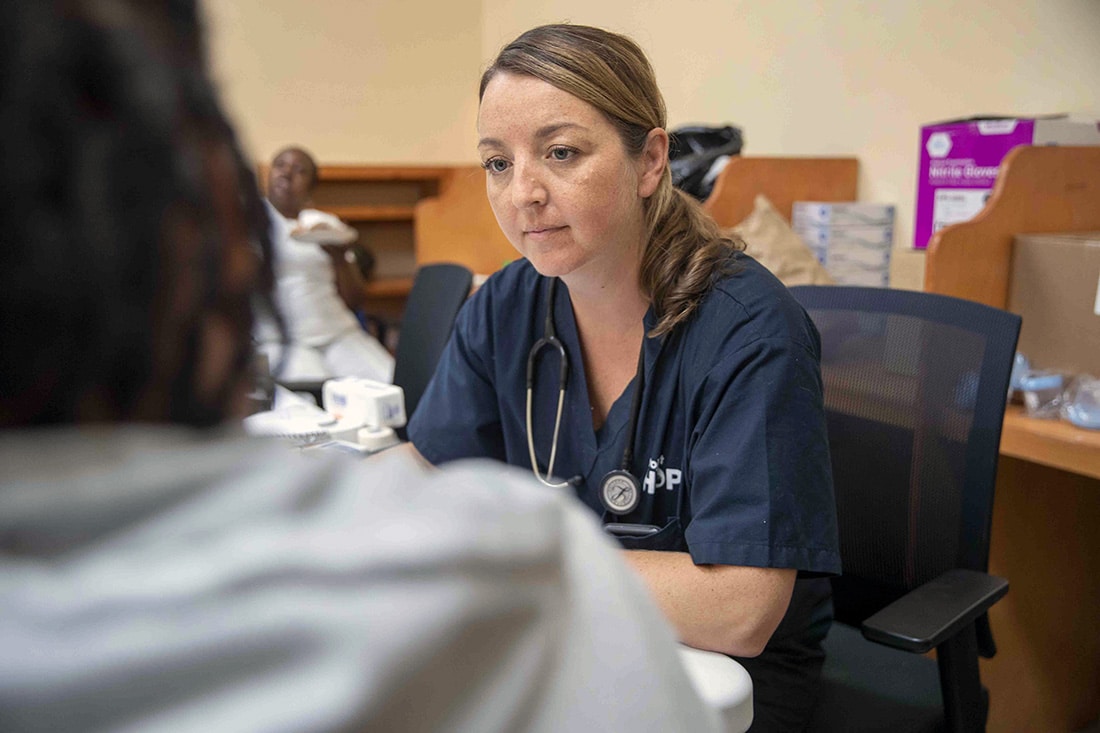
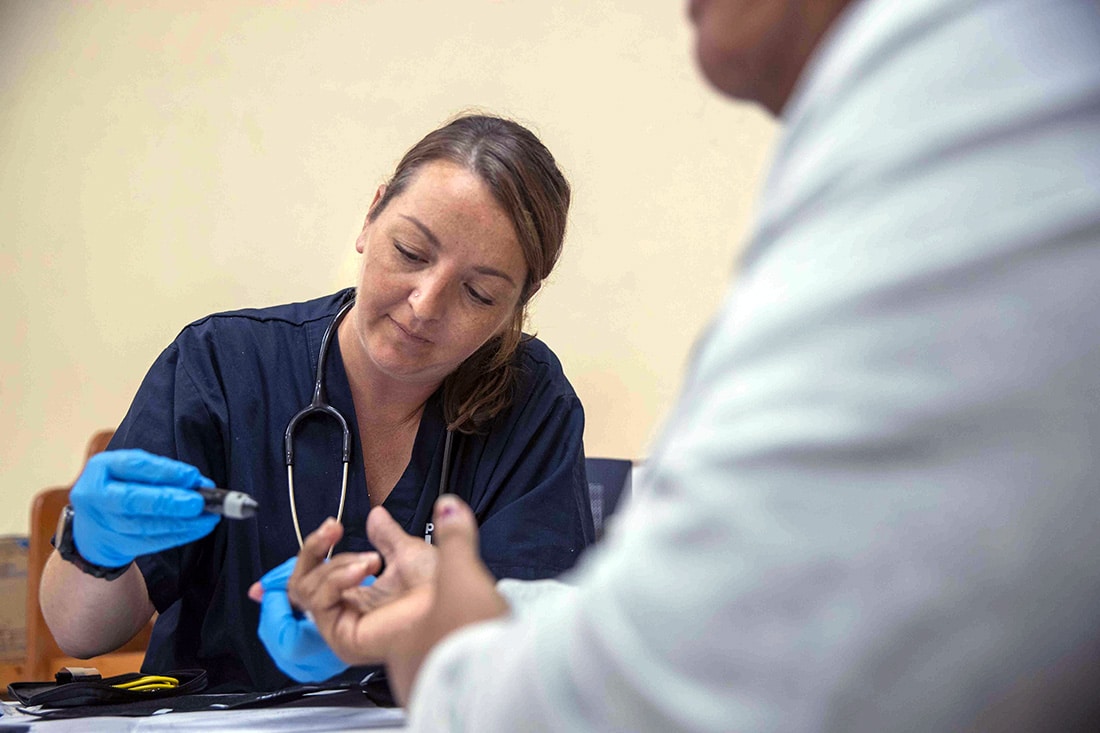
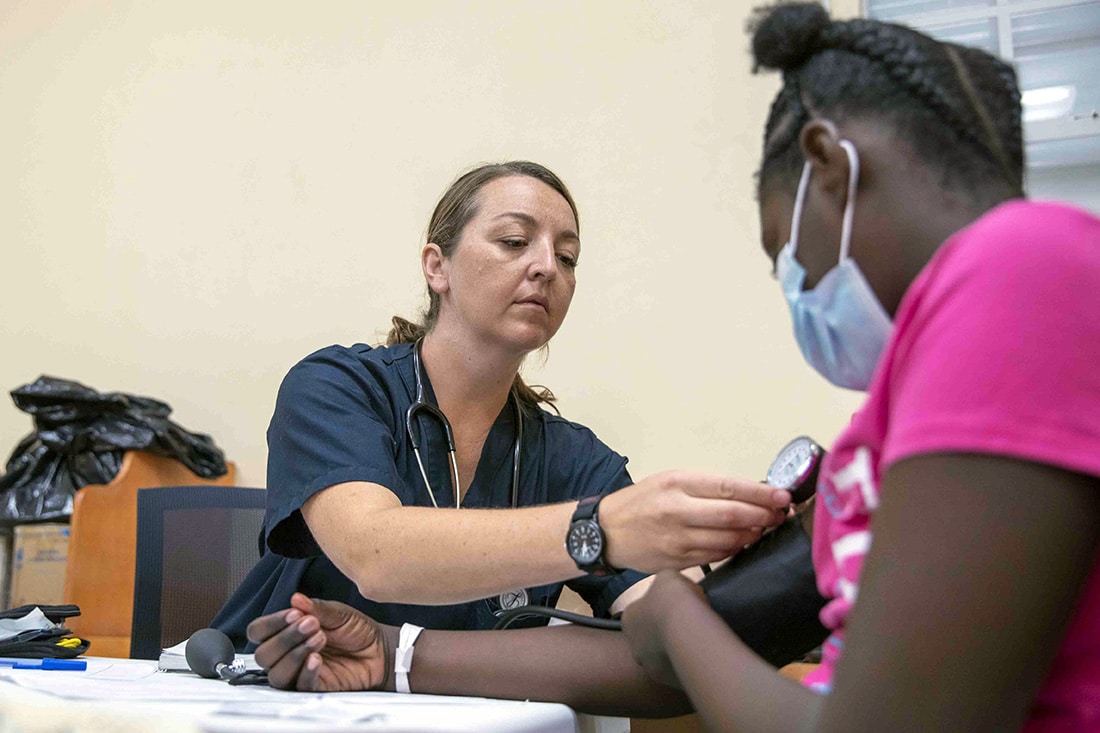
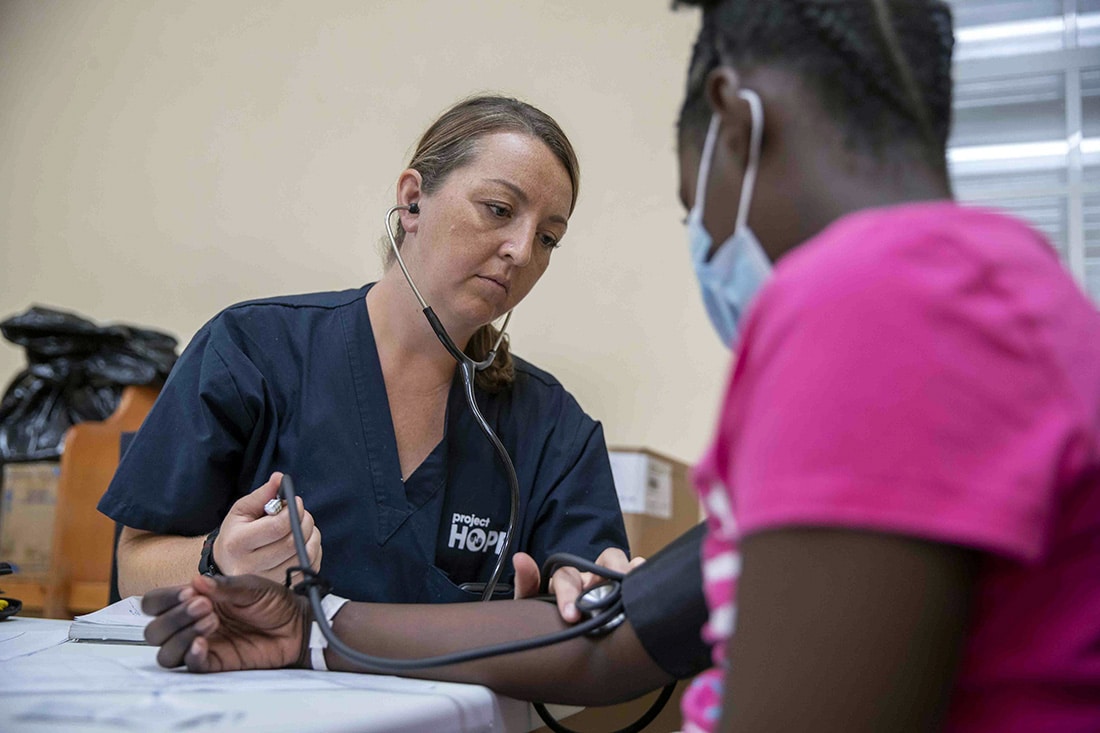
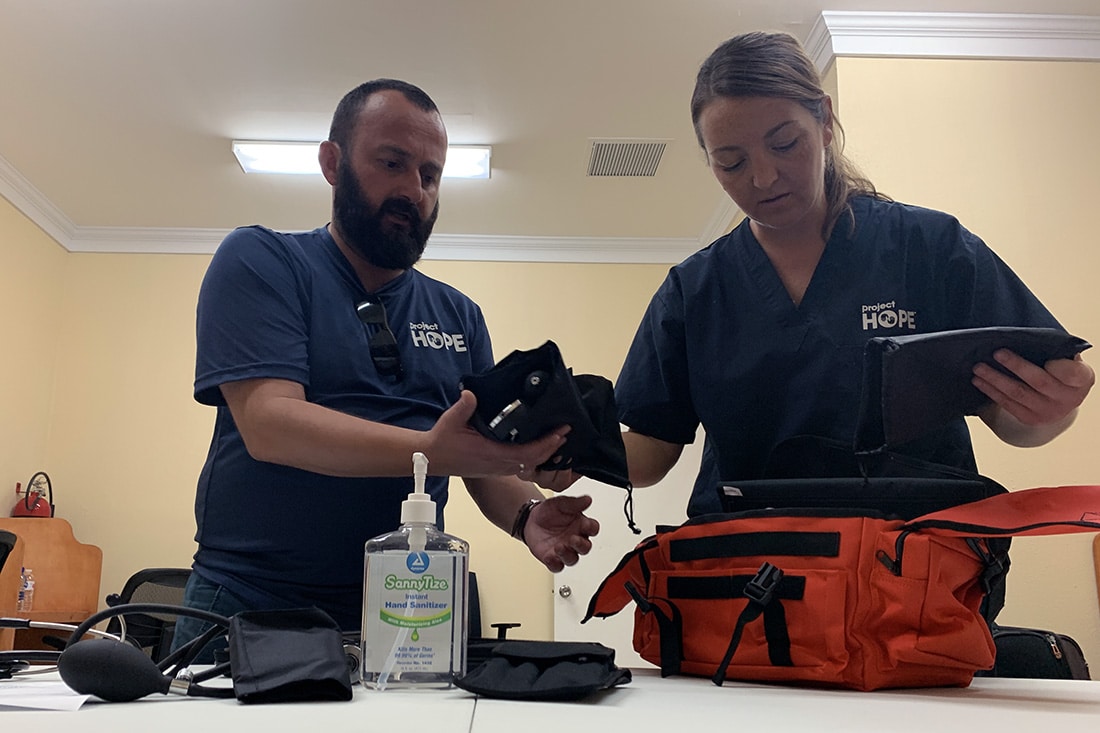
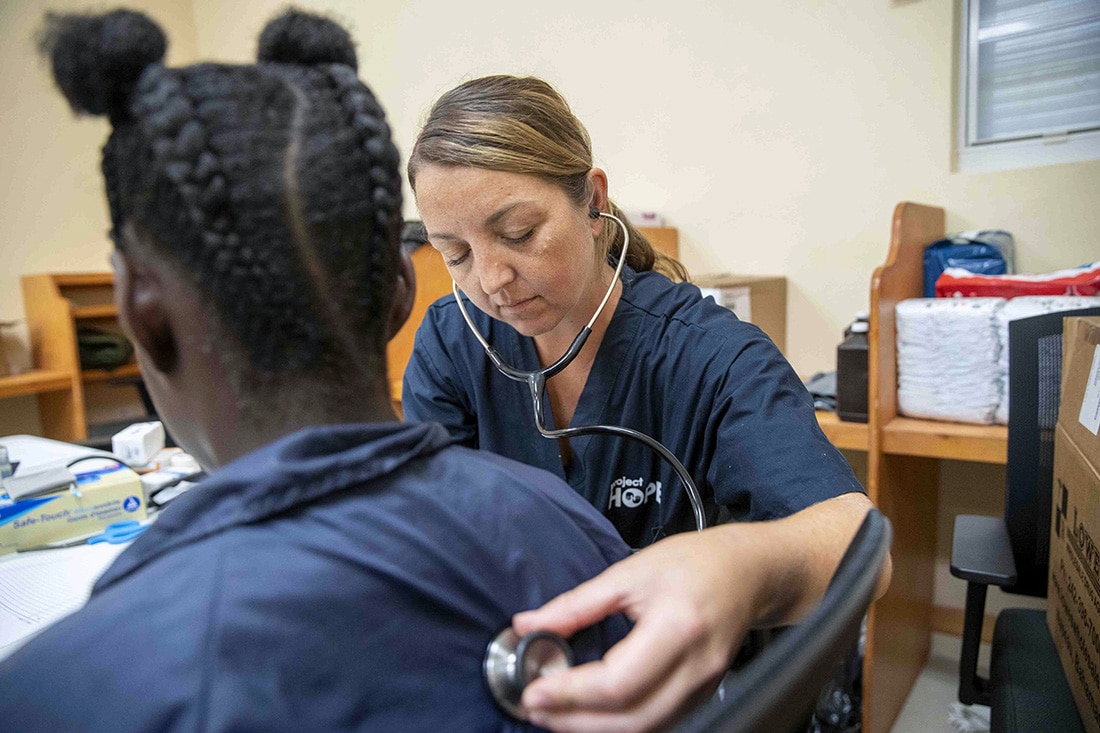






September 11, 2019: Project HOPE Continues Emergency Support as Another Tropical System Eyes the Bahamas
As more evacuees arrive in Nassau from Abaco and Grand Bahama Island, Project HOPE continues distributions of medical supplies and support for communities as they face monumental recovery from Hurricane Dorian.
The number of evacuees in Nassau has more than doubled in the last three days and is now over 2,000. To help meet their immediate health needs, our emergency response team in Nassau is opening a wellness station that includes blood pressure checks, lung/breathing checks and glucose tests for evacuees.
Project HOPE has also distributed an additional 1,000 hygiene kits donated by MAP International to the Adventist Development & Relief Agency, which is operating in Freeport, Grand Bahama and in Nassau. HOPE continues its support for Marsh Harbour Community Clinic on Abaco and has helped establish a pharmaceutical inventory system to manage donations and supplies.
Communities on Abaco and Grand Bahama Island are preparing for the risk of additional flooding and storm damage as a tropical system impacts the Bahamas later this week. The storm, which could develop into Tropical Storm Humberto, will likely bring an additional one to three inches of rain to communities already facing enormous recovery from Hurricane Dorian. Project HOPE is monitoring the storm and is ready to assist as needed.
September 9, 2019: Project HOPE Continues to Support Emergency Response in Marsh Harbour and Nassau
Project HOPE continues to support the hardest-hit communities in the Bahamas, including the delivery of essential medical supplies like insulin needles and phenobarbital to Marsh Harbour Community Clinic on Abaco Island. Though most people have evacuated Abaco for shelter in Nassau, many remain behind to receive medical treatment, and immediate needs include water, food, medicines and hygiene and sanitation supplies.
As evacuees arrive in Nassau, our team is focused on working with shelters to help assess their health needs while continuing our support for those in Abaco.
“At some point, people are going to want to go back home — maybe not all of them, but certainly some will,” says Tom Cotter, Project HOPE’s director of emergency response. “We have to have systems in place to support them through reconstruction. It’s difficult to look past the next day or two, but we really need to start taking a multi-week approach to this, which we will. Project HOPE is not only meeting immediate needs, but we’re looking to restore the health care infrastructure in the affected areas.”
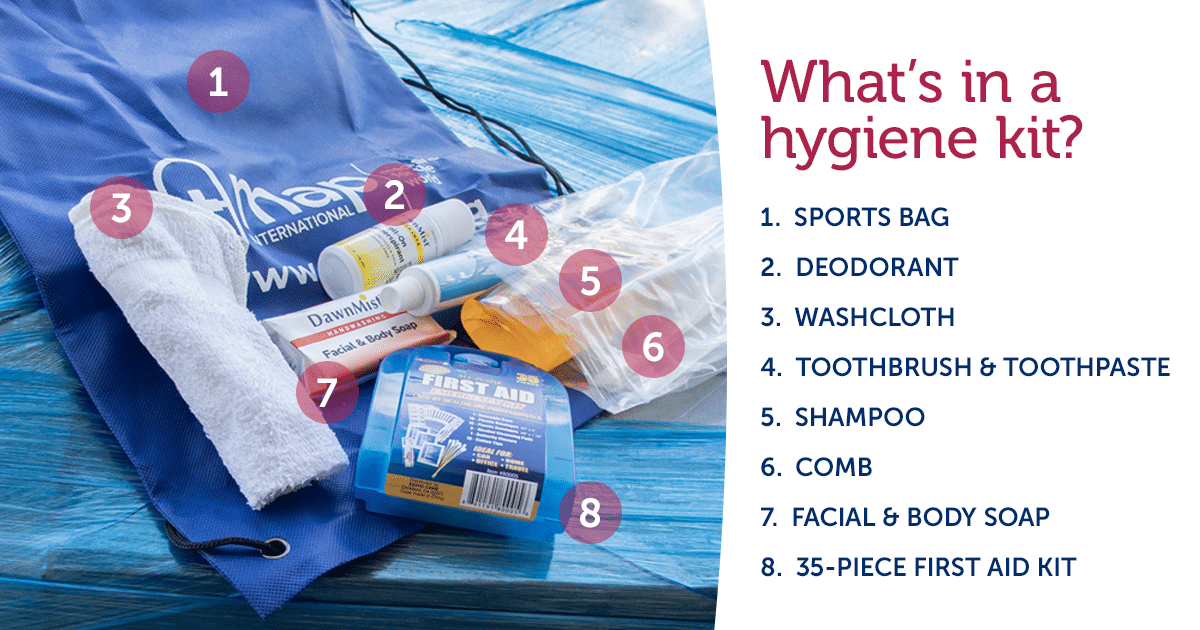
September 8, 2019: First Distribution of Medical Supplies Delivered to Marsh Harbour Community Clinic on Abaco
One week after Hurricane Dorian devastated the island of Abaco, the first distribution of medical supplies has been delivered to the island’s Marsh Harbour Community Clinic via helicopter. The delivery includes trauma supplies, gauze, bandages, diapers and cleaning supplies for the hospital.
As waters have receded around Marsh Harbour’s airport, many people from the island have been able to evacuate, though the hospital still faces critical shortages of medicines and supplies including insulin needles and phenobarbital, a drug to treat seizures. Project HOPE is working to coordinate delivery of these items as quickly as possible.
Additionally, Project HOPE has delivered 1,000 hygiene kits donated by MAP International to Fox Hill Community Center in Nassau. These kits include items like shampoo, soap, a toothbrush, deodorant, washcloth and a first-aid kit.
We remain very concerned about water quality and the storm’s impact on water infrastructure and are monitoring the possibility of disease outbreak closely.
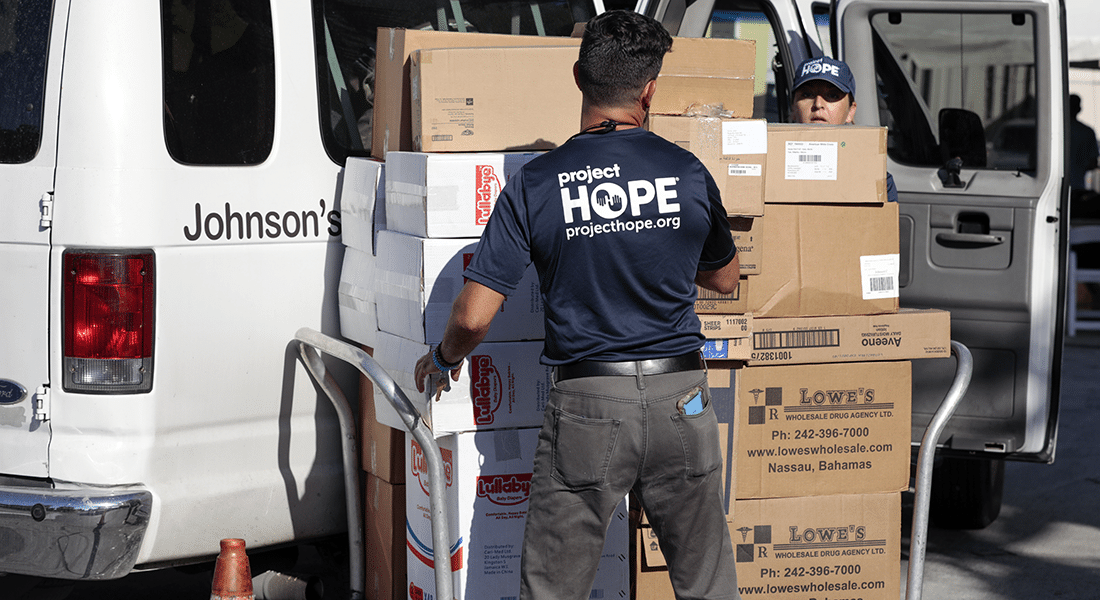
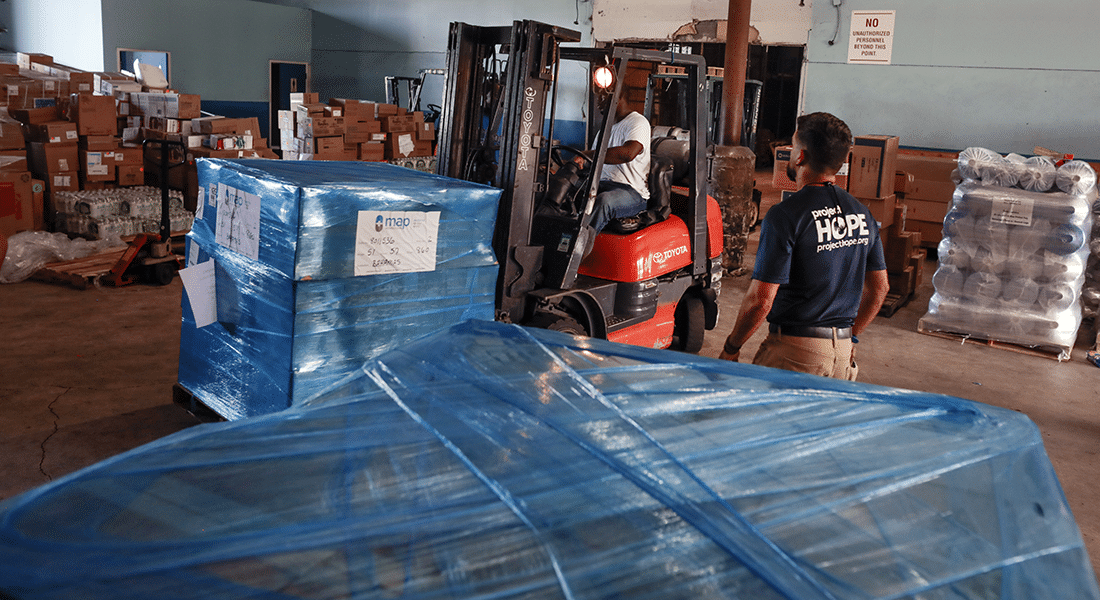
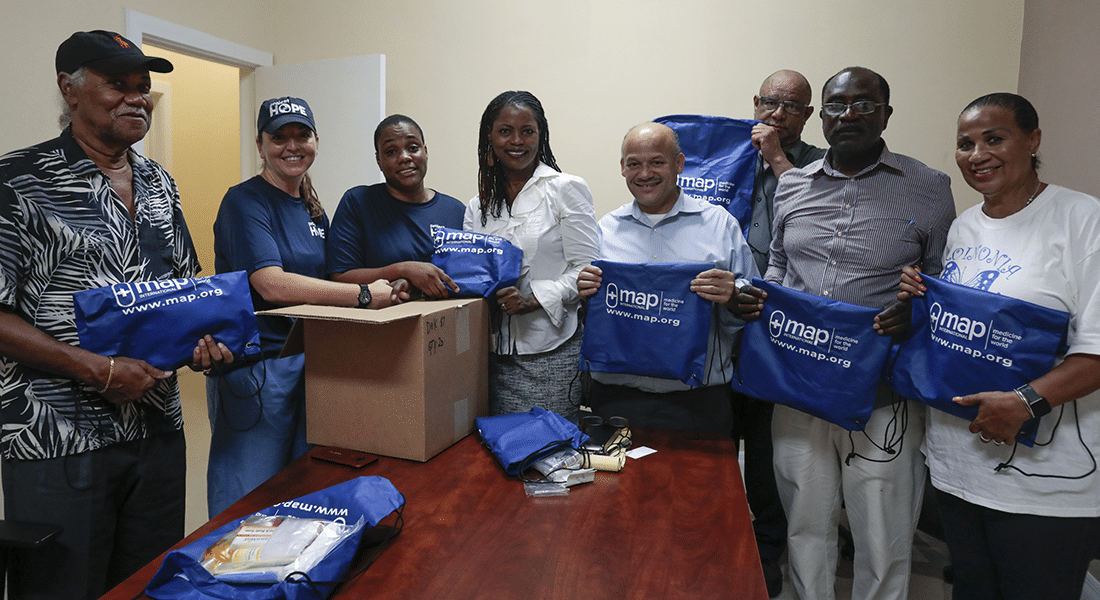
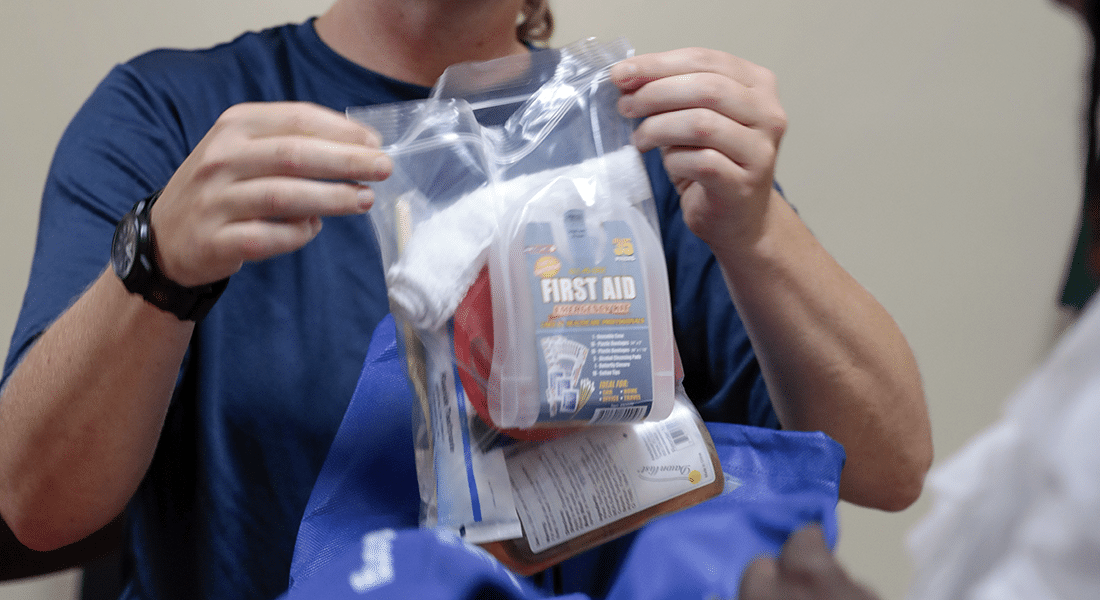
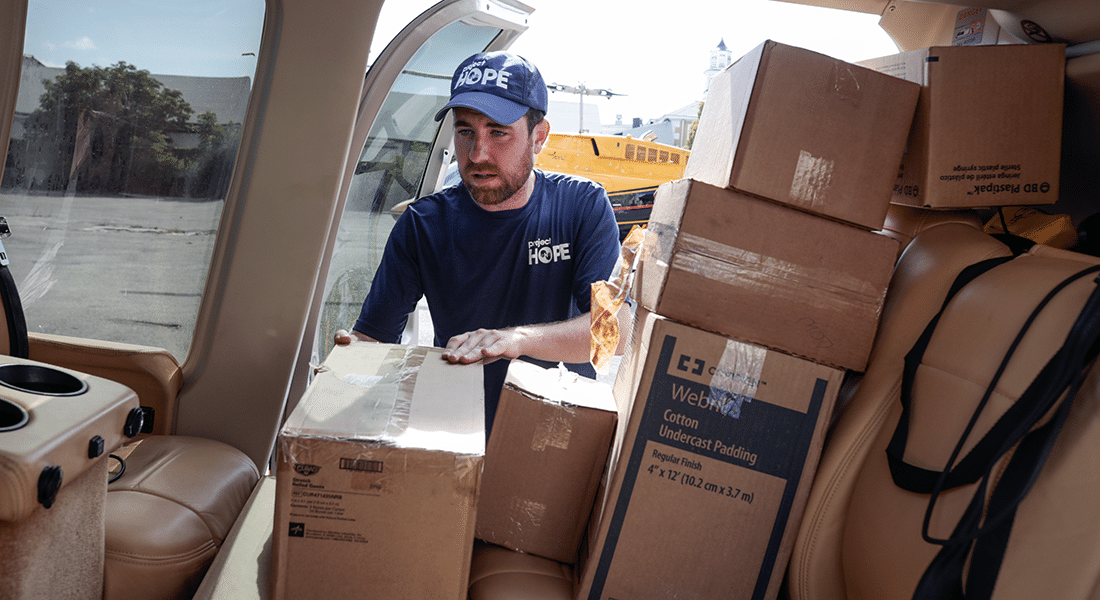
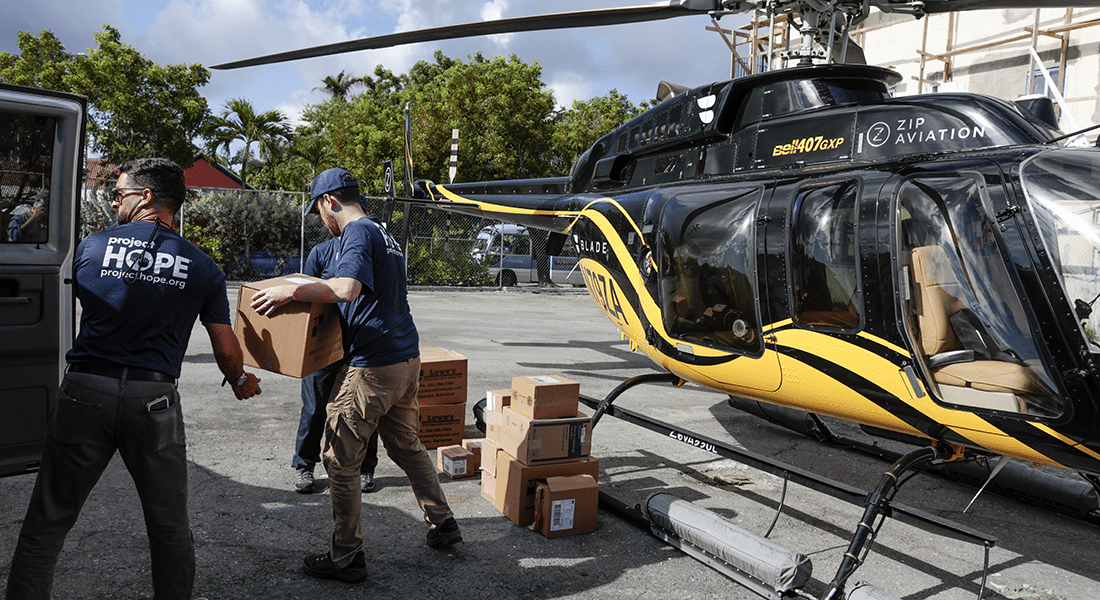
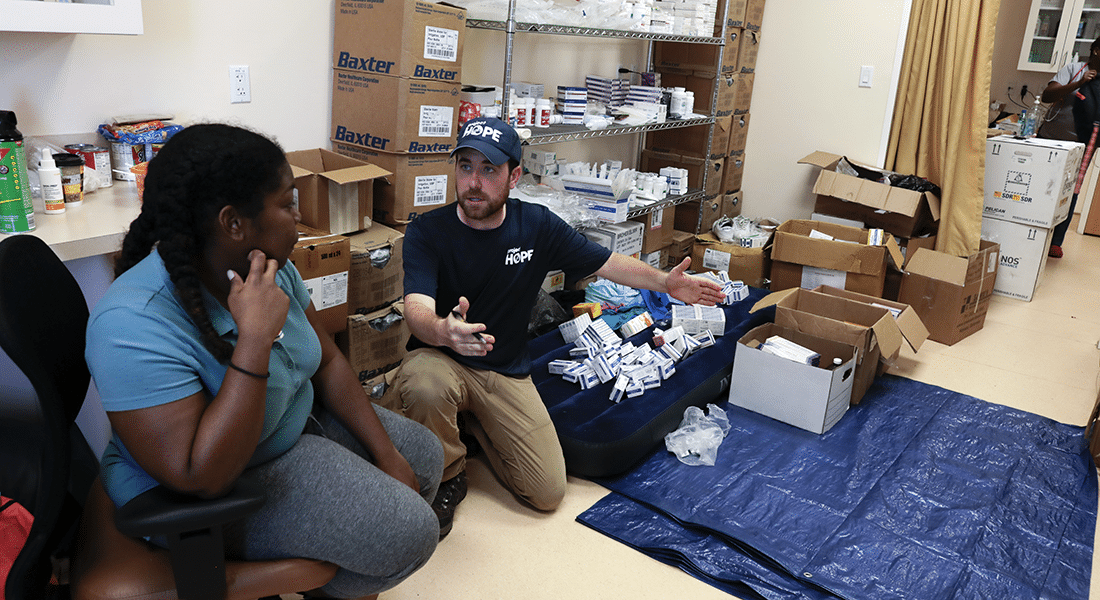
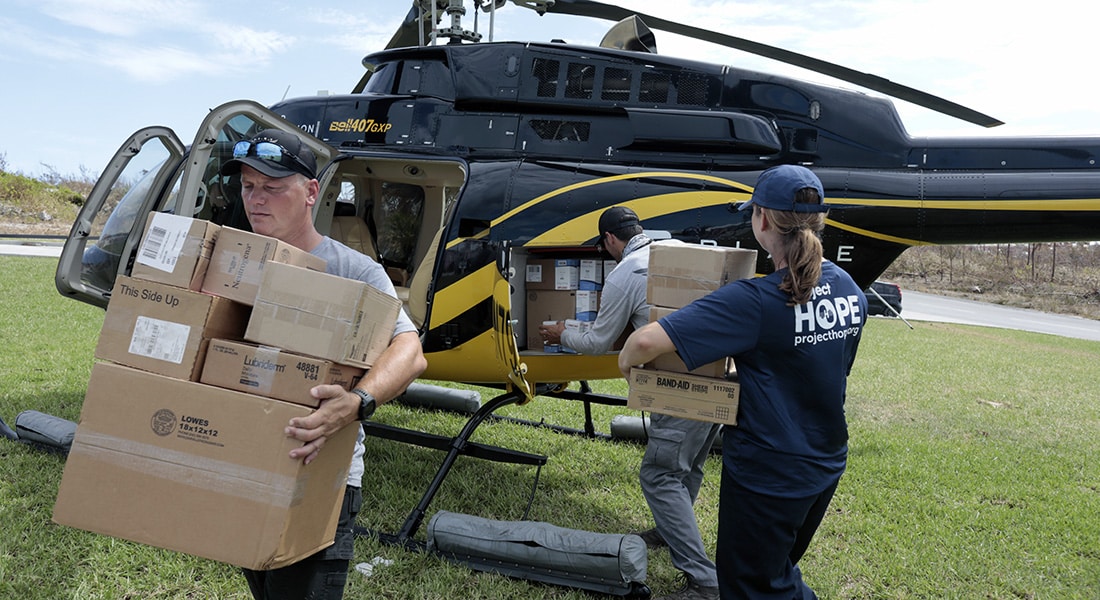








Friday September 6, 2019: Project HOPE Coordinates First Emergency Deliveries to Abaco
Project HOPE’s emergency response team remains on the ground in Nassau, coordinating with Restoration Abaco to assess the most pressing needs and deliver emergency medical supplies.
A barge loaded with critically needed items including soap, toothbrushes, toothpaste, deodorant, diapers and first aid kits is currently on its way to Abaco and expected to arrive Saturday morning. Additionally, a shipment of 2,160 disaster hygiene kits donated by MAP International has arrived in Nassau and should be transported to Abaco, also on Saturday. Access to the island remains extremely challenging as the airport can only accommodate small planes and only steel-hulled vessels can navigate the debris in the water.
“I haven’t seen destruction like this in quite some time,” says Tom Cotter, Project HOPE’s director of emergency response. “It’s breathtaking. There’s going to continue to be a need here for quite some time as people start to rebuild. The most important thing is that we get back and start sending medicine and medical supplies now. Now that we have a needs list, we know exactly what they need and we’re going to get it to them.”
Thursday, September 5, 2019: Project HOPE Is Assessing Damage in Abaco
Project HOPE is in the Bahamas, working to gain access to the affected areas and organize shipments of medicines and supplies. This morning, Tom Cotter, Project HOPE’s director of emergency response, took a plane to Abaco with partners from Restoration Abaco to assess needs and survey damage. All buildings and structures observed were damaged or destroyed.
“Hurricane Dorian had sustained winds of 185 mph. Any object hitting you at that speed will cause serious injury.”
At the hospital, Cotter saw a waiting room packed with patients, most with traumatic injuries. “Hurricane Dorian had sustained winds of 185 mph. Any object hitting you at that speed will cause serious injury,” he says. With nowhere else to go, many survivors are setting up tents on the hospital lawn. The U.S. Coast Guard is evacuating the most seriously injured by helicopter to either Nassau or Miami.
Access to the island remains difficult. A moat of water surrounds the airport runway, and the control tower is down. Small eight-seater planes are landing and taking off three at a time, carrying survivors to Nassau. Evacuation to safety and shelter is an excruciatingly slow process.
A shipment of more than 2,100 disaster hygiene kits is expected to arrive in Nassau tomorrow, where a portion of them will be transported to Abaco by Restoration Abaco. A barge that was loaded yesterday with hygiene kits, drinking water, medicines and medical supplies is expected to leave tonight.
Our team says that the needs they observed in Abaco were extensive, including trauma response at the hospital. To support our emergency relief efforts and all of our lifesaving work around the world, please visit projecthope.org/respond.
Wednesday, September 4, 2019: Project HOPE Is on the Ground in the Bahamas
Project HOPE’s initial response team landed in Nassau today and met with the Office of the Prime Minister and senior health officials to closely coordinate our response. We’ve teamed up with Restoration Abaco, a local Bahamian organization founded three days ago, “born of tragedy” and committed to the relief and recovery of their own.
Together we loaded a barge in Nassau with hygiene kits, four pallets of drinking water, medicines and medical supplies. Weather permitting, the barge will set sail early Thursday morning for the 10- to 12-hour journey to Abaco, where the items will be distributed.
Our team says that although Nassau shows little physical sign that a major storm passed through, the trauma of Nassau residents and those who evacuated here is evident: “I’ve never seen the level of trauma following a disaster that I’m seeing here,” says Tom Cotter, Project HOPE’s director of emergency response.
“Everywhere we go, people are crying.”
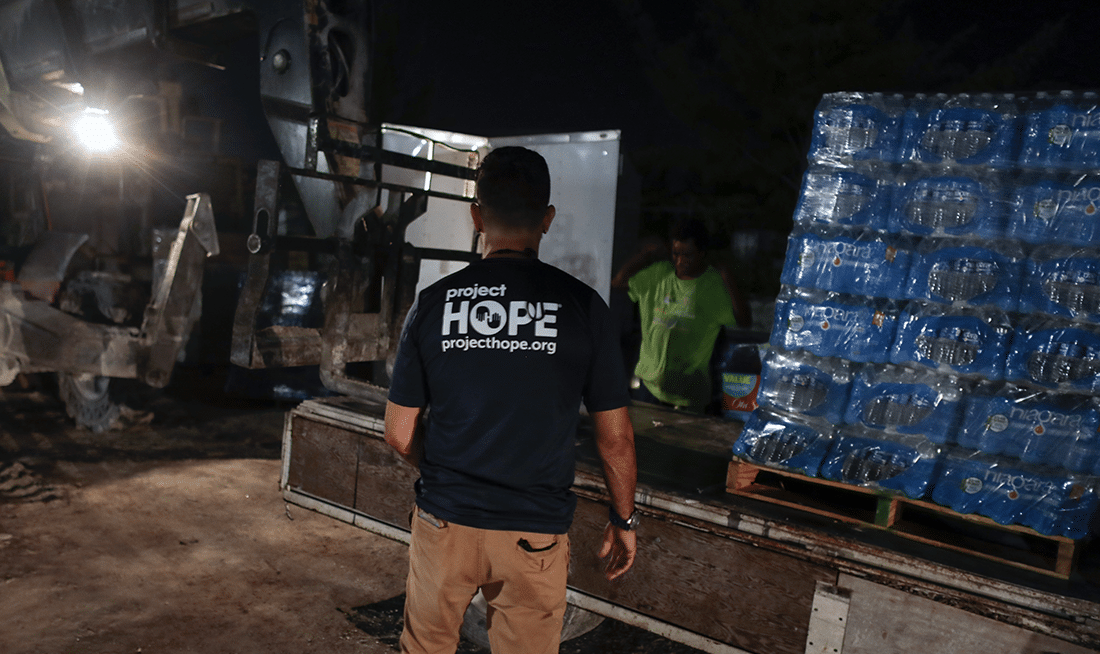
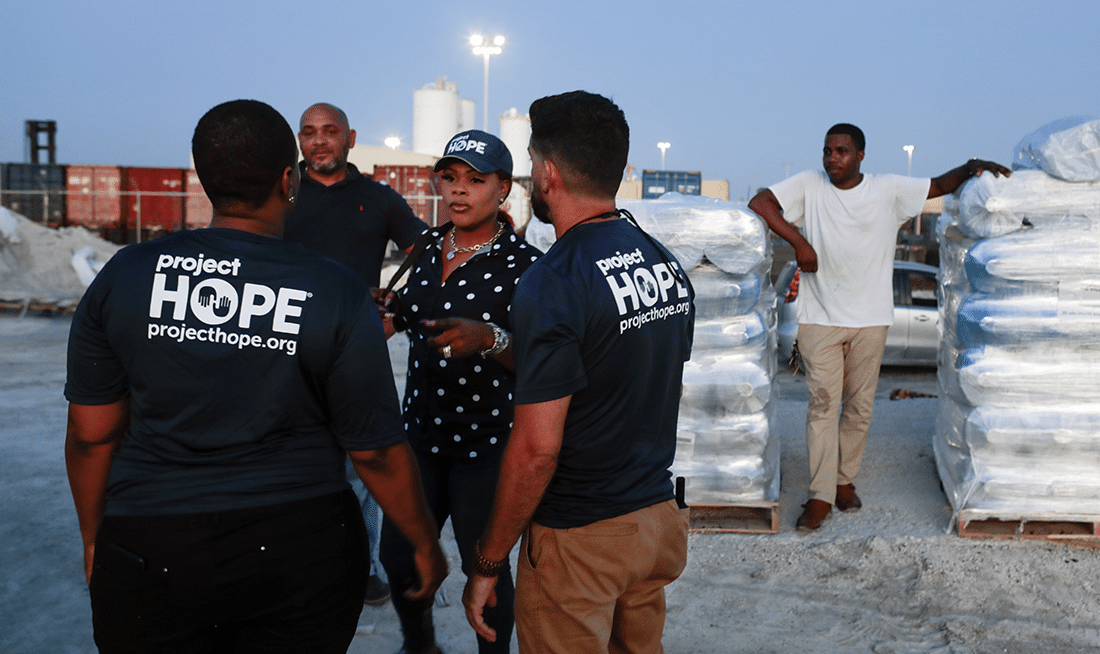
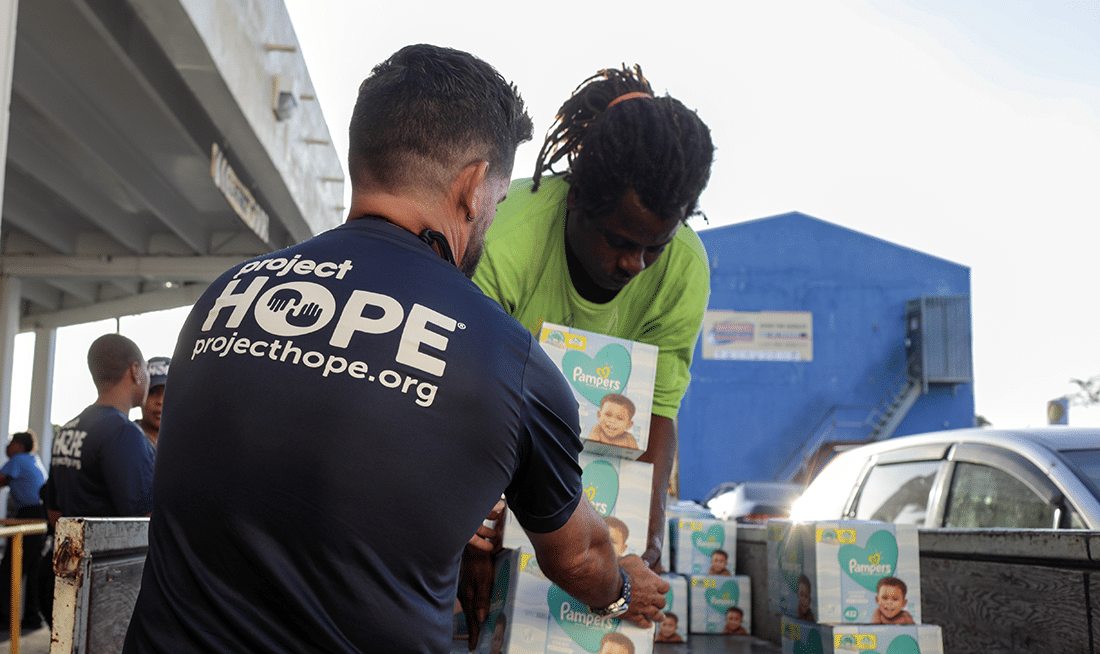
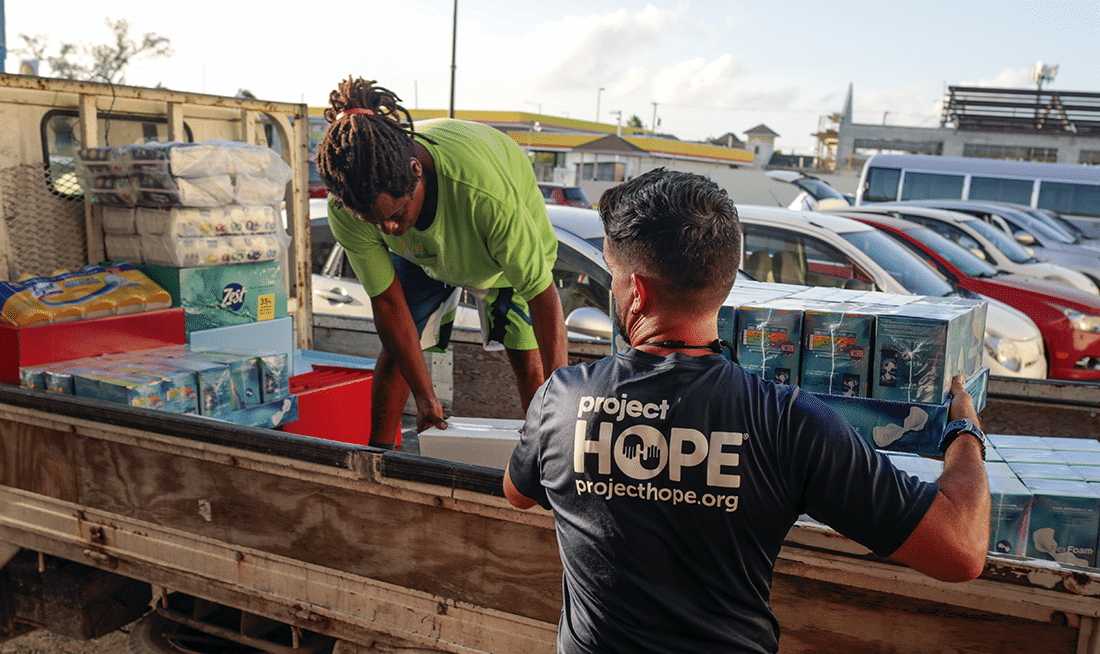




Tuesday September 3, 2019: Project HOPE Deploys Emergency Team to the Bahamas
As Hurricane Dorian continues on its destructive path, Project HOPE is deploying an emergency response team to the Bahamas for arrival by Wednesday morning. The first team we are mobilizing includes a physician, nurse practitioner and logistician, in addition to our director of emergency response. Some 30 Project HOPE doctors, nurses and pharmacists are ready to deploy as soon as is feasible. We are also working with partners to organize shipments of hygiene kits and other essential supplies to the Bahamas. The situation on the ground remains fluid but we know the damage is extreme and that severe flooding is hampering rescue efforts.
At Project HOPE, we go where the need is greatest. To support our emergency relief efforts and all of our lifesaving work around the world, please visit projecthope.org/respond.
Monday September 2, 2019: Project HOPE Gets Ready For Hurricane Dorian
As Hurricane Dorian makes its way to the United States, the global health and humanitarian organization Project HOPE is building its medical team and coordinating with partners to prepare to ship urgently needed health supplies to impacted areas along the coastal U.S. The organization is also prepared to support emergency response efforts in the Bahamas, should the government request international assistance.
“Considering Dorian’s strength, we must be ready to respond as soon as moving people and supplies into affected areas is feasible. That’s why we’re working now to put our medical team on standby,” says Chris Skopec, executive vice president of Global Health at Project HOPE. “From past experience, we know that local health workers will be as affected as their neighbors, and we will be ready to support them in the aftermath of the storm.”
“From past experience, we know that local health workers will be as affected as their neighbors, and we will be ready to support them in the aftermath of the storm.”

Get The Facts: What You Need To Know and How To Help
About Hurricane Dorian
Hurricane Dorian was one of the strongest Atlantic hurricanes ever recorded and the strongest to ever hit the Bahamas. More than 76,000 people were affected across Grand Bahama and Abaco, and more than 13,000 houses on Abaco were destroyed. Two months after the storm, the death toll is still being tabulated as the clearing of debris continues.
How strong was Dorian when it made landfall? How does it compare to previous hurricanes? What are the greatest needs facing the Bahamas? Get the quick facts below.
How strong was Hurricane Dorian when it made landfall?
Hurricane Dorian hit the Bahamas as a Category 5 hurricane before making landfall in North Carolina as a Category 1 storm.
Dorian struck the Bahamas as a devastating Category 5 hurricane with wind gusts over 220 miles per hour. By the time it made landfall in North Carolina, its sustained winds had decreased to 90 miles per hour and the main threats from the storm were flooding and storm surge.
Dorian tied the record for the strongest storm ever recorded in the Atlantic and was the strongest to ever hit the Bahamas. Part of the reason the damage is so widespread is because Dorian slowed to a 1-mile-per-hour crawl over the islands, pounding them for nearly 48 hours with torrential rains and winds that can tear apart buildings.
What happened in the Bahamas?
Dorian has caused “unprecedented” damage on the Bahamian islands of Abaco and Grand Bahama Island, with entire communities destroyed by the historic storm.
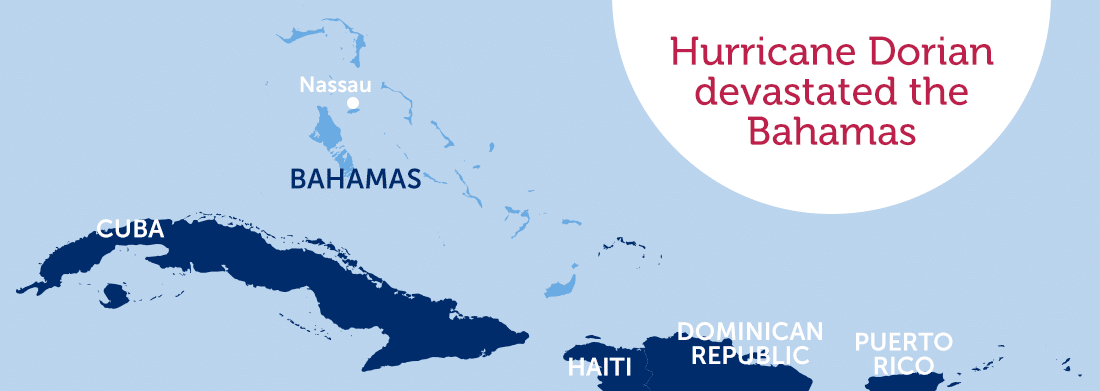
Bahamas prime minister Hubert Minnis has said that the damage on the islands is “unprecedented” and that the Bahamas are in “the midst of a historical tragedy.”
The Abaco Islands and Grand Bahama Island in particular suffered catastrophic damage. The Abacos are a sparsely populated chain of islands, cays and rocks that are mostly inhabited by fishermen, manual laborers and Haitian immigrants. Whole towns have been wiped out on Great Abaco Island, and officials have warned that the death toll could be very high.
How does this storm compare to recent hurricanes?
Dorian is one of the strongest hurricanes ever recorded in the Atlantic and the first Category 5 storm to hit Grand Bahama Island.
Dorian’s sustained wind speeds when it made landfall in the Bahamas were 185 miles per hour—stronger than Hurricane Michael (2018), Hurricane Irma (2018) and Hurricane Maria (2017). Its sustained winds tied the record for landfall in the Atlantic, which was set in 1935.5 Before Dorian, a Category 5 storm had never hit Grand Bahama Island.
According to the Saffir Simpson Hurricane Wind Scale, Category 1 winds (Dorian’s status when it made landfall in North Carolina) can cause “very dangerous winds,” with power outages that could last for days. The Category 5 winds that hit the Bahamas are catastrophic and can level entire buildings.
What is the greatest need?
Even as the focus of the response shifts into long-term recovery, areas that suffered the highest levels of devastation still need basic supplies like food and clean water, and all health facilities on Abaco Island are in need of infrastructure repair and restoration.
With parts of Abaco and Grand Bahama Island suffering total devastation, many communities in the Bahamas will take years to rebuild. Recovery is slow as thousands of people remain displaced, and the Bahamas’ national minister of Social Services and Urban Development has said there is “a sense of urgency” to get people into more stable housing. The Red Cross estimates that as many as 13,000 homes may have been destroyed.
Shortly after the storm, many people evacuated from Abaco to New Providence Island, either to stay in shelters or with friends and family. For those on Abaco, however, the need is still immense: Every health facility on the island is in need of repair, and there are still widespread gas and electricity shortages. There is no way to buy food or water, and massive piles of debris line the roads.
What is Project HOPE doing to help?
Project HOPE has provided direct care to more than 1,300 patients in the Bahamas and distributed more than $719,000 in medicines and supplies. Today, we’re working with our partners to help meet the health needs of evacuees and support long-term recovery on Abaco.
Project HOPE has delivered essential medical supplies to Abaco’s Marsh Harbour Community Clinic, including gauze, bandages, diapers, cleaning supplies, insulin needles and phenobarbital. Additionally, we have delivered tens of thousands of hygiene kits donated by MAP International and the Church of Latter-day Saints to various shelters, as well as pharmaceuticals and supplies to the Ministry of Health.
In shelters in and around Nassau, HOPE has provided exams, wellness checks and referrals for evacuees with medical conditions like hyperglycemia, hypertension and bronchitis. Our team also provided health screenings for more than 600 evacuee children attending school in Nassau. In October, HOPE began implementing first-aid training for evacuees on New Providence Island and is working to expand the trainings to communities on Abaco.
More than 25 expert volunteers have been deployed to provide direct patient care in the Bahamas, including five physicians, two registered nurses and a nurse practitioner. In total, Project HOPE has provided direct care to more than 1,300 patients and distributed more than $719,000 in medicines and supplies. Our response is expected to go through at least the end of December.
Project HOPE has the ability to rapidly get shipments approved, cleared and distributed and continues to accept offers of donated goods, including medical equipment, medical supplies, pharmaceuticals, water purification units and hygiene kits.

You can help!
Our ability to respond quickly when hurricanes, earthquakes and other natural disasters strike, even as we continue our lifesaving work around the world, depends on the generosity of people like you.
Please make a generous donation to our Global Health Emergency Fund today. You’ll help us prepare for emergencies before they happen and respond quickly when disaster strikes, so we can help communities around the world when we’re needed most.